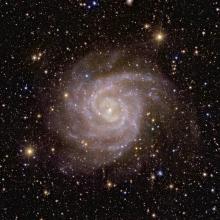Listen to today's episode of StarDate on the web the same day it airs in high-quality streaming audio without any extra ads or announcements. Choose a $8 one-month pass, or listen every day for a year for just $30.
You are here
Still Hunting
Like the search for cities of gold in the American west, the search for dark matter keeps coming up empty. But scientists keep devising new tools and techniques for continuing the search.
One big difference between the two searches is that scientists are certain that dark matter exists. It exerts a gravitational pull on the visible matter around it.
Dark matter appears to account for about 85 percent of all the matter in the universe. But no one knows what dark matter is. The leading idea says it consists of subatomic particles. They’d be hard to find, though, because they wouldn’t interact with normal matter.
Most of the direct searches look for a particle of dark matter to hit or pass near a particle of normal matter. That would give the normal particle a slight nudge, causing it to “jiggle” — or to produce a flash of light.
Detectors are placed deep underground, where interference from other particles is screened out. One research group, in Italy, has reported several detections of dark matter. But no other experiments have been able to replicate the result.
An upgraded detector is being prepared in an abandoned gold mine in South Dakota. Known as Lux-Zeplin, it’ll contain more than 10 tons of liquid xenon. Scientists hope dark matter will stage occasional interactions with the molecules of xenon — confirming the existence of the stuff that makes up most of the matter in the universe.
More about dark matter tomorrow.
Script by Damond Benningfield





